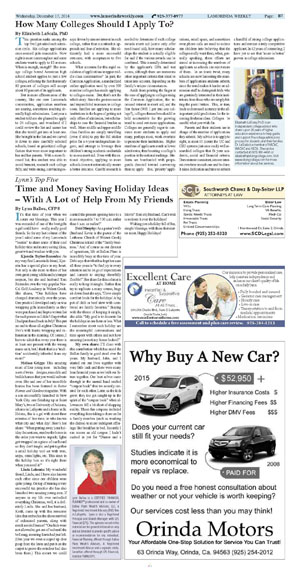|
|
Published December 17th, 2014
|
How Many Colleges Should I Apply To?
|
|
| By Elizabeth LaScala |
 |
| Elizabeth LaScala, Ph.D. is an independent college advisor who draws upon 25 years of higher education experience to help guide and support the college admissions process for students and their families. Dr. LaScala is a member of NACAC, WACAC and HECA. She can be contacted at (925) 891-4491 or elizabeth@doingcollege.com. Visit www.doingcollege.com for more information about her services. |
This question ranks among the top five I get asked each admission cycle. Six college applications once seemed quite reasonable. Now eight is more commonplace and some students want to apply to 10 or more. When is enough, enough? The average college bound American high school student applies to just a few colleges, reflecting the fact that nearly 80 percent of colleges still accept about 80 percent of its applicants.
 But in more affluent areas of the country, like our own Lamorinda communities, application numbers are soaring, sometimes reaching absurdly high submissions. Last year a student told me she planned to apply to 24 colleges, and wondered if I could review the list and assure her that she would get into at least one. She brought in the list and we carved it down to nine carefully selected schools, based on prioritized college factors that were most important to her and her parents. With a more focused list, this student was able to avoid burnout, research each college fully, and write strong, convincing essays driven by sincere interest in each college, rather than a scattershot approach and fear of rejection. She ultimately had a more successful outcome, with acceptances to five schools.
But in more affluent areas of the country, like our own Lamorinda communities, application numbers are soaring, sometimes reaching absurdly high submissions. Last year a student told me she planned to apply to 24 colleges, and wondered if I could review the list and assure her that she would get into at least one. She brought in the list and we carved it down to nine carefully selected schools, based on prioritized college factors that were most important to her and her parents. With a more focused list, this student was able to avoid burnout, research each college fully, and write strong, convincing essays driven by sincere interest in each college, rather than a scattershot approach and fear of rejection. She ultimately had a more successful outcome, with acceptances to five schools.
 What accounts for this rapid escalation of applications in upper middle class communities? In part, the Common Application, a standardized online application used by over 500 member colleges has made applying to colleges easier. But, that's not the whole story. Since the great recession and unparalleled increases in college costs, families are applying to more institutions in the hopes of getting not only offers of admission, but scholarships to ease the financial burden as well. More middle and upper middle class families are simply unwilling (even if able) to pay the full sticker price for a 4-year undergraduate degree, and attempt to leverage their children's strong academic credentials to access merit aid. Even with this rational objective, applying to more schools does not automatically ensure a better outcome. Careful research is needed to determine if each college awards merit aid (some only offer need-based aid), how many scholarships the student is actually eligible for and if the various awards can be combined. This is usually determined by the applicant's GPA and test scores, although there are numerous other important criteria that must be taken into account, depending on the family's unique circumstances.
What accounts for this rapid escalation of applications in upper middle class communities? In part, the Common Application, a standardized online application used by over 500 member colleges has made applying to colleges easier. But, that's not the whole story. Since the great recession and unparalleled increases in college costs, families are applying to more institutions in the hopes of getting not only offers of admission, but scholarships to ease the financial burden as well. More middle and upper middle class families are simply unwilling (even if able) to pay the full sticker price for a 4-year undergraduate degree, and attempt to leverage their children's strong academic credentials to access merit aid. Even with this rational objective, applying to more schools does not automatically ensure a better outcome. Careful research is needed to determine if each college awards merit aid (some only offer need-based aid), how many scholarships the student is actually eligible for and if the various awards can be combined. This is usually determined by the applicant's GPA and test scores, although there are numerous other important criteria that must be taken into account, depending on the family's unique circumstances.
 Aside from pointing the finger at the ease of applying to colleges using the Common Application, the increased interest in merit aid, and the fear factor (Will I get into any college?), colleges themselves should be held accountable for the growing trend to send out more applications. Colleges are generally eager to convince more students to apply and many, perhaps most, work overtime to promote their institutions. Higher numbers of applicants result in lower admit rates, thus boosting a college's position in the national rankings. Students are bombarded with propaganda directed toward convincing them to apply - free, 'priority' applications, email spam, and sometimes even phone calls are used to seduce our children into believing that the colleges really want them, when, generally speaking, these efforts are aimed at increasing the numbers of applicants so schools can reject more of them. In an ironic twist, many schools are now lamenting the numbers of applications students submit, since the trend makes it harder on admission staff to distinguish kids who are genuinely interested in their institutions from those who are simply hitting the panic button. This, in turn, leads to decreased accuracy in the all-important yield predictions for the incoming freshman class. Colleges - be careful what you wish for.
Aside from pointing the finger at the ease of applying to colleges using the Common Application, the increased interest in merit aid, and the fear factor (Will I get into any college?), colleges themselves should be held accountable for the growing trend to send out more applications. Colleges are generally eager to convince more students to apply and many, perhaps most, work overtime to promote their institutions. Higher numbers of applicants result in lower admit rates, thus boosting a college's position in the national rankings. Students are bombarded with propaganda directed toward convincing them to apply - free, 'priority' applications, email spam, and sometimes even phone calls are used to seduce our children into believing that the colleges really want them, when, generally speaking, these efforts are aimed at increasing the numbers of applicants so schools can reject more of them. In an ironic twist, many schools are now lamenting the numbers of applications students submit, since the trend makes it harder on admission staff to distinguish kids who are genuinely interested in their institutions from those who are simply hitting the panic button. This, in turn, leads to decreased accuracy in the all-important yield predictions for the incoming freshman class. Colleges - be careful what you wish for.
 Parents and their students are in charge of the number of applications they submit. My advice is to apply to eight, at most 10 (count the UC and CSU systems just once each) well researched colleges that fit your academic, social and financial criteria. Demonstrate consistent, sincere interest over time in each one and be done. It takes dedication and time to submit a handful of strong college applications and remain a truly competitive applicant. In 12 years of counseling, I have yet to see that 'more is better' proven in college admissions.
Parents and their students are in charge of the number of applications they submit. My advice is to apply to eight, at most 10 (count the UC and CSU systems just once each) well researched colleges that fit your academic, social and financial criteria. Demonstrate consistent, sincere interest over time in each one and be done. It takes dedication and time to submit a handful of strong college applications and remain a truly competitive applicant. In 12 years of counseling, I have yet to see that 'more is better' proven in college admissions.

|
|
|
|
|
|
|
|
|
| |
|
|
|
|



